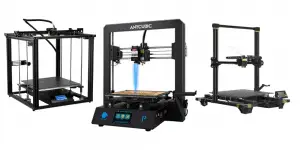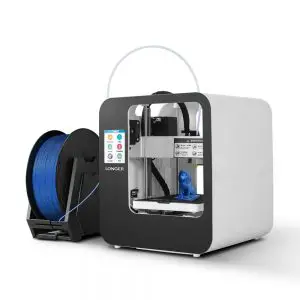FlashForge Guider 2 Technical Specifications
Max Print Size: (1102 x 9.84 x 11.81 inches) (280x250x300mm)
File Format: STL/OBJ
Supported Filament Types: PLA, PLA Color Change, ABS, ABS Pro, HIPS, Pearl, Elastic, PVA, PETG, TPE, TPU, PP, Conductive Filament, Flexible Filament, Wood Filled Filament, Metal Filled Filament
Filament Diameter: 1.75mm
Printer Speed: 24cc/h, or 100 mm/s
Extruders: One
Extruder Diameter: 0.4mm
Printing Plate: heated
Design and Features
The FlashForge Guider 2 is a second-generation printer that is the follow up to the Flashforge Guider. The first thing that you might notice is that the build plate on the new release is 70 percent bigger than the original. This is an excellent improvement if you want to do larger prototyping and printing. This newer printer model has several other improvements that move this printer up in quality.
The second major improvement is that the nozzle has been redesigned to assure more airflow. This resulted in improvements in print quality and consistency. Several different nozzles are now available. This allows you to print using a wider range of materials. One thing that people who used the original Flashforge Guider consistently comment about is the sharpness and precision of the newer model. Flashforge has been known for quality products, but the new Guider II creates professional-quality prints that are good enough for engineering and prototyping.
Another thing that made a difference is that the printer now has assisted auto-leveling. This makes set up quick, and you no longer have to mess with using a piece of paper. Another thing they added is the Resume Print function. If the power goes out, which can happen if someone trips over the cord, then you do not have to scrap the model and start over. All you have to do is press Resume Print, and it will just pick up where it left off. It also has filament run-out detection so that you do not get any surprises.
The frame itself is plastic-alloy. It feels sturdy, but it is a bit heavy to move. It might be a bit more difficult to move, but that is what you expect from this level of a machine. One thing that we liked is that the print plate is removable. This is something that you do not find on many machines. It makes set up and clean up easier.
Printing
Flashforge added a lot of nice features to Guider 2, but the bottom line is how well it prints. In this respect, there are few printers in this price range that can compete with this one. It can create a layer thickness of 0.1-0.5mm, which is thin enough the create some incredible detail. The positioning precision is 11 microns on the X and Y axis and 2.5 microns on the Z-axis. The layer resolution is + /- 0.2mm. This level of precision is more than fine enough to do professional printing and small-production parts runs.
The printer is a bit slower, depending on the type of filament that you are using and the precision level. This is to be expected, and it can move along at lower resolutions at around 24 cc/hour, which is 100 mm/s. That is pretty fast for a machine of this precision. It is worth the wait for the print quality that it produces.
It has a heated nozzle of 0-240C, and the printer bed can heat to 120C. This helps to get an even thickness and create sturdy, even objects. The printer is also quiet when it is running. The print chamber is closed, which means that the prints will not be affected by ambient air temperature and ambient air movement. This also improves the quality of the print.
This version of the FlashForge Guider is compatible with Windows XP and above, MAC OS X, and Linux systems. It has a 5-inch color IPS touchscreen. You can upload designs using a USB stick, USB cable, Wi-Fi, and an Internet connection. It is compatible with FlashPrint slicing software. This printer offers many options when it comes to compatibility. This is another thing for which Flashforge is known in the world of 3D printers.
Packing and Assembly
The Guider 2 comes with a Quick Start Guide that will get you up and printing quickly. The User Manual is well-written and easy to follow. One tip is to be sure to read the User Guide first. They provide complete unpacking and step by step assembly instructions.
The unit comes in a single box. It is well-packed with the unit protected by foam. You are instructed to remove all of the foam first, then lift the unit out. You might want a second set of hands for this. You will need one to lift the unit and one to hold the box down because it is packed tightly. In the bottom of the carton, you will find the filament spool, power cable, USB cable, spool holder, filament guide tube, a glue stick, and tool bag. In the tool bag, you will find a USB stick, 2 Allen wrenches, one stamping wrench, and an unclogging pin tool. You will also find grease and a screwdriver.
The box contains everything that you need, and you need to supply nothing else. Most of the unit comes preassembled, and the step by step instructions are clear with excellent illustrations and pictures. It is an easy unit to put together, get set up, and get ready to print.
Support
One thing that Flashforge is known for is excellent product support. All of the manuals are available for free download from their site. You can also easily download Flashprint software, too. Chapter 8 of the User Guide gives you many different ways to get help.
The website has an extensive knowledge base that is easy to navigate. There are also several online communities dedicated to Flashforge users. You can also contact them through their website, by phone, and they provide their physical address. They typically provide a quick response by email and get back the same or following business day. Phone support is available during regular business hours PST Monday – Saturday. Overall, the support service is excellent and easy to navigate when you have a need.
FlashForge Guider 2 Pros & Cons
Here are the major pros and cons of the Guider 2 3D printer.
Pros
- Highly precise prints
- Quiet operation
- Prints many different materials
- Several different nozzles available
- Large, heated print bed
- Resume print function
- Compatible with most operating systems
Cons
- Unit itself is a bit difficult to move
- Prints a bit hard to remove
- Nozzle clogs difficult to reach and clear
Verdict
This FlashForge Guider 2 3D printer review found that this leader in the 3d printing industry included a lot of nice upgrades and features in this model. It is easy to use and produces professional prints of high quality. Set up and assembly are easy, and it is easy to level. The removable printer bed and multiple nozzle tips make this a versatile model. One of its most impressive features is the range of filaments that it can print. You can extend your capabilities well beyond the basics. This model is much more than a printer for kid’s toys. The quality of the prints is up there too.
There are a lot of things to like about this unit and not too many things not to like. Overall, we think this is one of the best 3d printers in this price range and at this level of professionalism. It would be the perfect machine or a serious hobbyist or a professional who needs to print a few parts now and then.
Last update on 2024-05-16 / Affiliate links / Images from Amazon Product Advertising API







